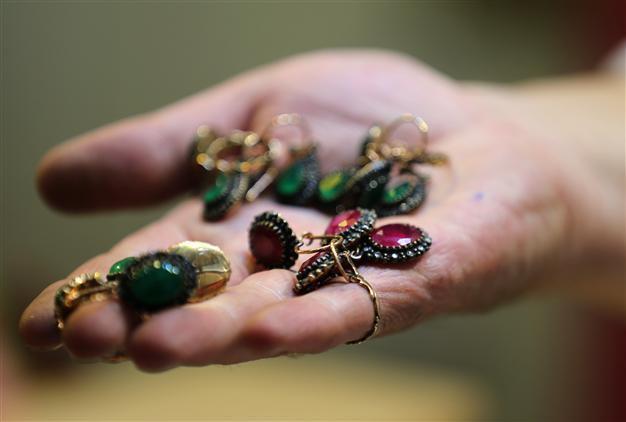Formerly glorious Ottoman jewelers on the verge of dying out
KÜTAHYA - Anadolu Agency

An earlier research had revealed an important record from the 1700s that relates to the intake of items such as fabric and jewelry crafted in Kütahya to the palace. Archives hold important documents which show that pens used in the palace. AA photo
Diamonds might be a girl’s best friend, but for the craftsmen of Kütahya who are trying to keep alive traditional forms of Ottoman jewelry-making, the precious stones are failing to show much love amid a drop in interest in the art form.
Doğan Şapçı, a master jeweler from a family that has been involved in the trade for the past eight generations, said he was happy to be maintaining the craft of his ancestors, but noted that the jewelers of Kütahya, who supplied the Ottoman court with jewels from the 1500s on, were being forced to adapt to changing modern preferences.
“We are trying to carry ancient designs to the future through restoration and new production. We are re-integrating these designs that are on the verge of disappearance into our productions,” Şapçı recently told Anadolu Agency.
Şapçı both restores old diamonds and creates new pieces based on known designs, later selling them for a diverse range of prices.
“Diamond jewelry has always been a passion for women. We are producing jewelry that medium-income groups can afford. Our price range runs from 700 Turkish Liras to 5,000 liras, depending on the value of the craft. All our pieces still preserve their attractiveness because they are all hand-made. This requires various unique techniques. In the end, all of our articles of jewelry are timeless,” Şapçı said.
Kütahya Deputy Gov. Mustafa İngenç said Ottoman archives hold important documents which show that pens used in the palace and Harem were produced in Kütahya. İngenç, who noted that during the reign of Germiyans, a beylik centered on Kütahya during the 14th and 15th centuries, fabrics were also produced in Kütahya to be sent to the Ottoman palace, said Kütahya was for a long time the site where jewelry, towels and fabrics were all produced to be sent to the Harem.
A research on historyThe official also said research had revealed an important record from the 1700s that relates to the intake of items such as fabric and jewelry crafted in Kütahya to the palace.

Vagabond of vagabonds, the famous Ottoman
traveler Evliya Çelebi's father lived in Kütahya in
the end of the 16th century. He was one of the chief
jewelers of the Sultan's court... AA photo.
“The father of Evliya Çelebi [the Ottoman Empire’s most famous traveler], Derviş Mehmet Zilli, lived in Kütahya. He was the chief jeweler of the empire in the 1500s, during the reigns of Süleyman the Magnificent and Ahmed I. He immigrated to Istanbul in the 1600s. When we evaluate all the documents and records, we see that both before and after the era of Süleyman I, the Ottoman palace and Harem officially received various items from Kütahya, which include earrings, necklaces, rings, nail clippers, fabrics, towels, purses and porcelain. It is possible to find many records about these in the archives,” he said. İngenç also said he had given a copy of the records to Şapcı.
Human relations with diamonds date back 3,000 years, during which period this precious stone both adorned love stories and became an embodiment of humanity’s ambition and greed. Diamonds have often mirrored people’s interior world, giving voice to their love, pride, happiness, envy and hatred. In the late 20th century, African countries like Sierra Leone suffered untold horrors in a civil war that was fueled by the quest to extract the country’s large number of diamonds. Some people also believed diamonds to be a talisman, able to protect them from the machinations of the evil.

